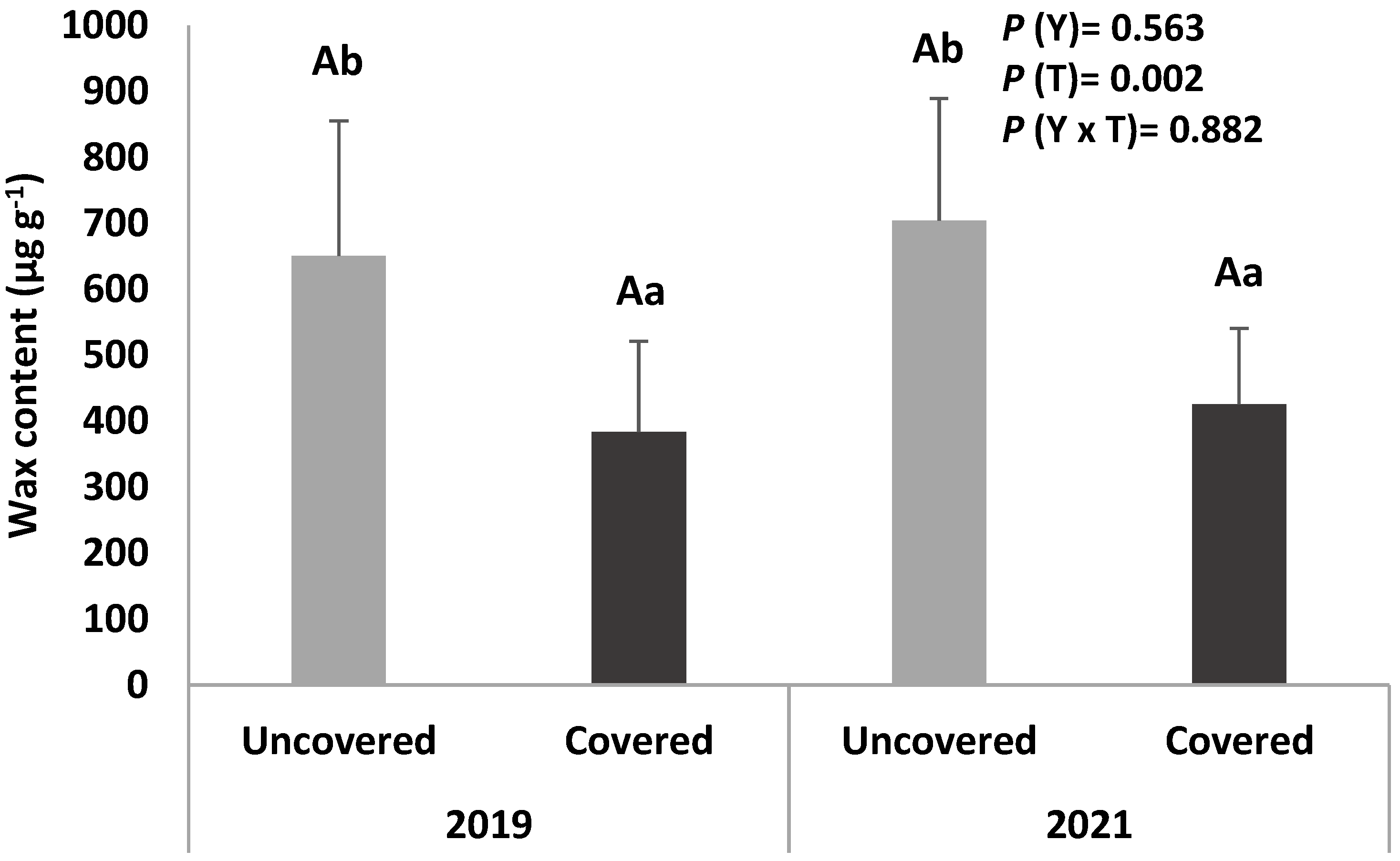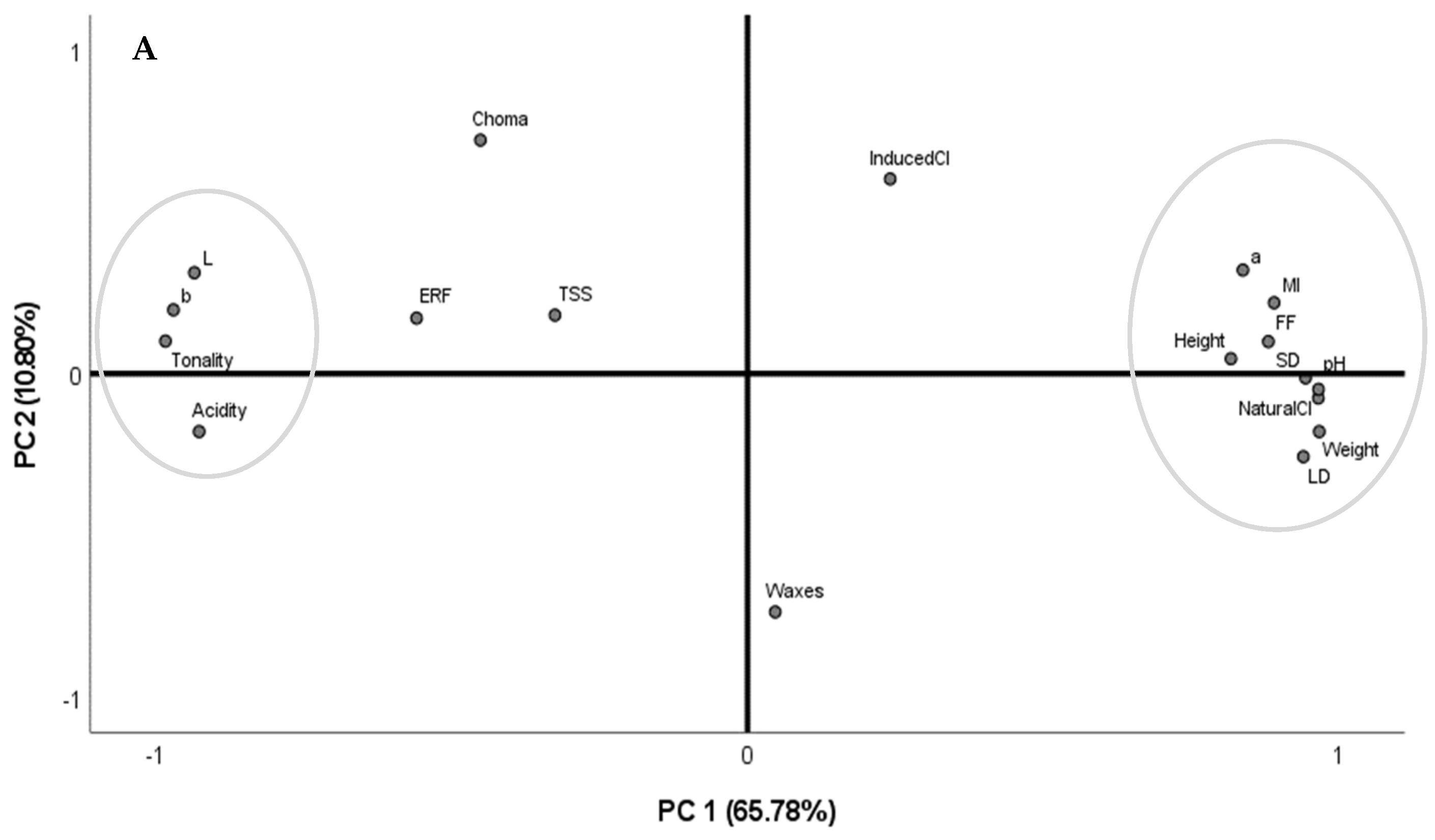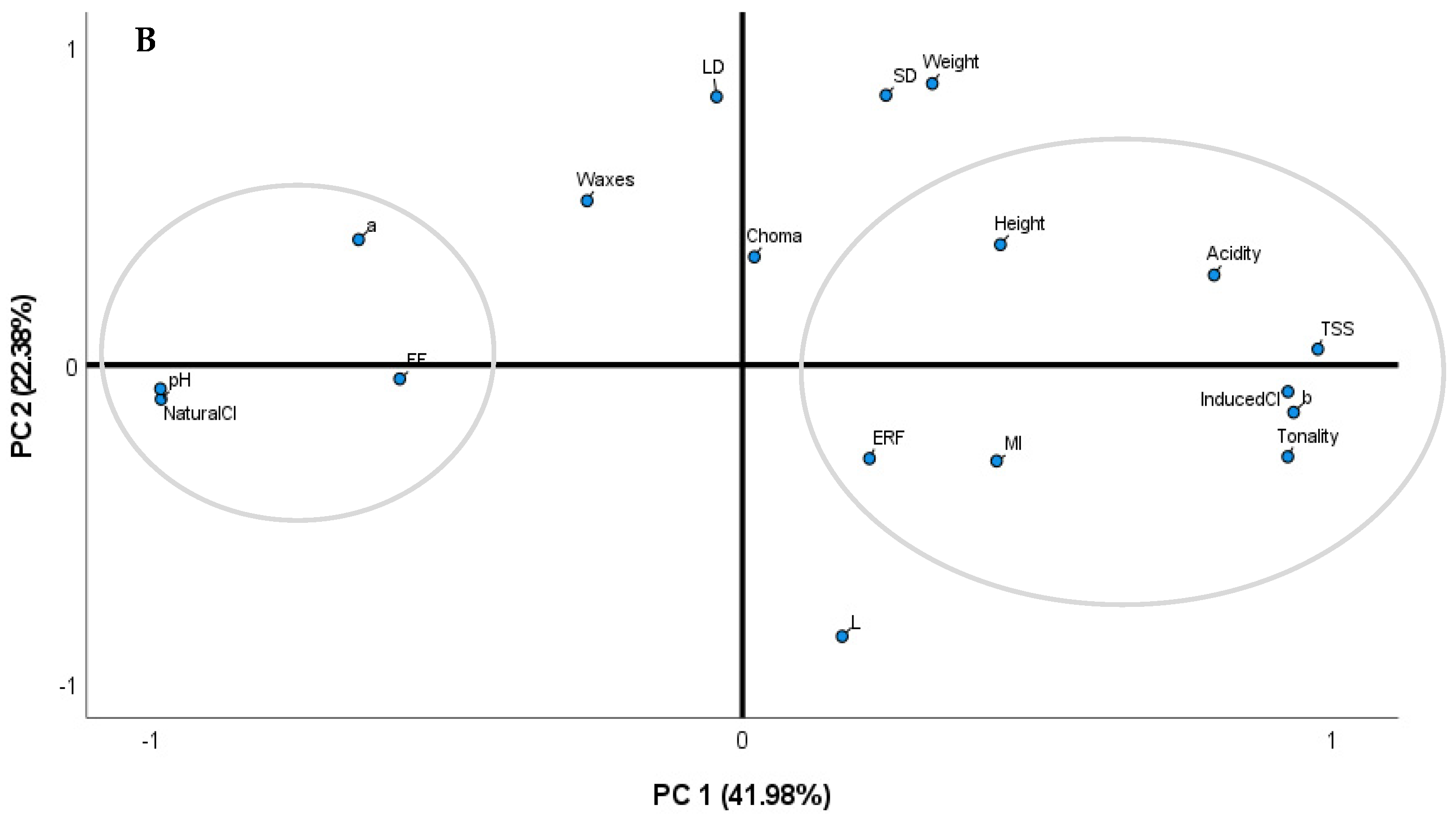Orchard Net Covers Improve Resistance to Cherry Cracking Disorder
Abstract
:1. Introduction
2. Materials and Methods
2.1. Experimental Trial
2.2. Natural Cracking Index
2.3. Induced Cracking Index and Crack Type Incidence
2.4. Epicuticular and Intra-Cuticular Wax Content
2.5. Quality Attributes of the Fruits
2.5.1. Weight and Dimensions
2.5.2. Chromatic Parameters
2.5.3. Epidermis Rupture Force—ERF and Flesh Firmness—FF
2.5.4. Total Soluble Solids, Titratable Acidity, Maturity Index, and pH
2.6. Statistical Analysis
3. Results and Discussion
3.1. Effect of Net Cover on Fruit Cracking Parameters
3.1.1. Natural Cracking Index
3.1.2. Induced Cracking Index and Crack Type Incidence
3.1.3. Epicuticular and Intra-Cuticular Wax Content
3.2. Effect of Cover Net on Other Quality Attributes of the Fruits
3.2.1. Weight and Dimensions
3.2.2. Chromatic Parameters
3.2.3. Epidermis Rupture Force and Flesh Firmness
3.2.4. Total Soluble Solids, Titratable Acidity, Maturity Index, and pH
3.3. Correlations
3.4. Principal Component Analysis
Author Contributions
Funding
Data Availability Statement
Acknowledgments
Conflicts of Interest
References
- Measham, P.F.; Gracie, A.J.; Wilson, S.J.; Bound, S.A. Vascular flow of water induces side cracking in sweet cherry (Prunus avium L.). Adv. Hortic. Sci. 2010, 24, 243–248. [Google Scholar] [CrossRef]
- Knoche, M.; Peschel, S. Water on the surface aggravates microscopic cracking of the sweet cherry fruit cuticle. J. Am. Soc. Hortic. Sci. 2006, 131, 192–200. [Google Scholar] [CrossRef] [Green Version]
- Correia, S.; Schouten, R.; Silva, A.P.; Gonçalves, B. Sweet cherry fruit cracking mechanisms and prevention strategies: A review. Sci. Hortic. 2018, 240, 369–377. [Google Scholar] [CrossRef]
- Knoche, M. Water uptake through the surface of fleshy soft fruit: Barriers, mechanism, factors, and potential role in cracking. In Abiotic Stress Biology in Horticultural Plants; Springer: Tokyo, Japan, 2015; pp. 147–166. [Google Scholar] [CrossRef]
- Koumanov, S. On the mechanisms of the sweet cherry (Prunus avium L.) fruit cracking: Swelling or shrinking? Sci. Hortic. 2015, 184, 169–170. [Google Scholar] [CrossRef]
- Knoche, M.; Winkler, A. Chapter 7: Rain-induced cracking of sweet cherries. In Cherries: Botany, Production and Uses; Quero-García, J., Iezzoni, A., Puławska, J., Lang, G., Eds.; CABI: Wallingford, UK, 2017; pp. 140–165. [Google Scholar] [CrossRef]
- Rehman, M.U.; Rather, G.H.; Dar, N.A.; Mir, M.M.; Iqbal, U.; Mir, M.R.; Fayaz, S.; Hakeem, K.R. Causes and prevention of cherry cracking: A review. In Crop Production and Global Environmental Issues; Springer: Cham, Switzerland, 2015; pp. 543–552. [Google Scholar] [CrossRef]
- Pereira, S.; Silva, V.; Bacelar, E.; Guedes, F.; Silva, A.P.; Ribeiro, C.; Gonçalves, B. Cracking in sweet cherry cultivars Early Bigi and Lapins: Correlation with quality attributes. Plants 2020, 9, 1557. [Google Scholar] [CrossRef]
- Christensen, J.V. Rain-induced cracking of sweet cherries: Its causes and prevention. In Cherries: Crop Physiology, Production and Uses; Webster, A.D., Looney, N.E., Eds.; CAB International: Wallingford, UK, 1996; pp. 297–327. [Google Scholar]
- Yamaguchi, M.; Sato, I.; Ishiguro, M. Influences of epidermal cell sizes and flesh firmness on cracking susceptibility in sweet cherry (Prunus avium L.) cultivars and selections. J. Jpn Soc. Hortic. Sci. 2002, 71, 738–746. [Google Scholar] [CrossRef]
- Simon, G.; Hrotkó, K.; Magyar, L. Fruit quality of sweet cherry cultivars grafted on four different rootstocks. Acta Hortic. 2004, 658, 65–370. [Google Scholar] [CrossRef]
- Edin, M.; Lichou, J.; Saunier, R. Cerise, Les Variétés et Leur Londuite; Ctifl; Diffusion, Lavoisier Tec & Doc: Paris, France, 1997; Volume 238, ISBN 978-2879110844. [Google Scholar]
- Balbontín, C.; Ayala, H.; Bastías, R.M.; Tapia, G.; Ellena, M.; Torres, C.; Yuri, J.A.; Quero-García, J.; Ríos, J.C.; Silva, H. Cracking in sweet cherries: A comprehensive review from a physiological, molecular, and genomic perspective. Chil. J. Agric. Res. 2013, 73, 66–72. [Google Scholar] [CrossRef] [Green Version]
- Alkio, M.; Jonas, U.; Sprink, T.; Van Nocker, S.; Knoche, M. Identification of putative candidate genes involved in cuticle formation in Prunus avium (sweet cherry) fruit. Ann. Bot. 2012, 110, 101–112. [Google Scholar] [CrossRef] [Green Version]
- Alkio, M.; Jonas, U.; Declercq, M.; Van Nocker, S.; Knoche, M. Transcriptional dynamics of the developing sweet cherry (Prunus avium L.) fruit: Sequencing, annotation and expression profiling of exocarp-associated genes. Hortic. Res. 2014, 1, 1–15. [Google Scholar] [CrossRef] [Green Version]
- Balbontín, C.; Ayala, H.; Rubilar, J.; Cote, J.; Figueroa, C.R. Transcriptional analysis of cell wall and cuticle related genes during fruit development of two sweet cherry cultivars with contrasting levels of cracking tolerance. Chil. J. Agric. Res. 2014, 74, 162–169. [Google Scholar] [CrossRef] [Green Version]
- Giné-Bordonaba, J.; Echeverria, G.; Ubach, D.; Aguiló-Aguayo, I.; López, M.L.; Larrigaudière, C. Biochemical and physiological changes during fruit development and ripening of two sweet cherry varieties with different levels of cracking tolerance. Plant Physiol. Biochem. 2017, 111, 216–225. [Google Scholar] [CrossRef]
- Jiang, F.; Lopez, A.; Jeon, S.; de Freitas, S.T.; Yu, Q.; Wu, Z.; Labavitch, J.M.; Tian, S.; Powell, A.L.T.; Mitcham, E. Disassembly of the fruit cell wall by the ripening associated polygalacturonase and expansin influences tomato cracking. Hortic. Res. 2019, 6, 1–15. [Google Scholar] [CrossRef] [Green Version]
- Breia, R.; Mósca, A.F.; Conde, A.; Correia, S.; Conde, C.; Noronha, H.; Soveral, G.; Gonçalves, B.; Gerós, H. Sweet cherry (Prunus avium L.) PAPIP1;4 is a functional aquaporin upregulated by pre-harvest calcium treatments that prevent cracking. Int. J. Mol. Sci. 2020, 21, 3017. [Google Scholar] [CrossRef] [PubMed]
- Michailidis, M.; Karagiannis, E.; Tanou, G.; Sarrou, E.; Karamanoli, K.; Lazaridou, A.; Martens, S.; Molassiotis, A. Sweet cherry fruit cracking: Follow-up testing methods and cultivar-metabolic screening. Plant Methods 2020, 16, 51. [Google Scholar] [CrossRef] [Green Version]
- Simon, G. Review on rain induced fruit cracking of sweet cherries (Prunus avium L.), its causes and the possibilities of prevention. Int. J. Hortic. Sci. 2006, 12, 27–35. [Google Scholar] [CrossRef] [Green Version]
- Correia, S.; Santos, M.; Glińska, S.; Gapińska, M.; Matos, M.; Carnide, V.; Schouten, R.; Silva, A.P.; Gonçalves, B. Effects of exogenous compound sprays on cherry cracking: Skin properties and gene expression. J. Sci. Food Agric. 2020, 100, 2911–2921. [Google Scholar] [CrossRef] [PubMed]
- Verner, L.; Blodgett, E.C. Physiological studies of the cracking of sweet cherries. University of Idaho. Agric. Exp. Stn. Bull 1931, 184, 1–15. [Google Scholar]
- Christensen, J.V. Cracking in Cherries III. Determination of cracking susceptibility. Acta Agric. Scand. 1972, 22, 128–136. [Google Scholar] [CrossRef]
- Hamilton, R.J. Waxes: Chemistry, Molecular Biology and Functions; Orly Press: Edinburgh, Scotland, 1995. [Google Scholar]
- Voss, D.H. Relating colourimeter measurement of plant colour to the royal horticultural society colour chart. HortScience 1992, 27, 1256–1260. [Google Scholar] [CrossRef]
- Hutchings, J.B. Food Colour and Appearance; Blackie Academic & Professional: London, UK, 1994; pp. 1–29. [Google Scholar]
- McGuire, R.G. Reporting of objective colour measurements. HortScience 1992, 27, 1254–1255. [Google Scholar] [CrossRef] [Green Version]
- Bernalte, M.J.; Hernández, M.T.; Vidal-Aragón, M.C.; Sabio, E. Physical, chemical, flavor and sensory characteristics of two sweet cherry varieties grown in ‘Valle del Jerte’ (Spain). J. Food Qual. 1999, 22, 403–416. [Google Scholar] [CrossRef]
- Gonçalves, B.; Silva, A.P.; Moutinho-Pereira, J.; Bacelar, E.; Rosa, E.; Meyer, A.S. Effect of ripeness and postharvest storage on the evolution of color and anthocyanins in cherries (Prunus avium L.). Food Chem. 2007, 103, 976–984. [Google Scholar] [CrossRef]
- Giménez, M.J.; Serrano, M.; Valverde, J.M.; Martínez-Romero, D.; Castillo, S.; Valero, D.; Guillén, F. Preharvest salicylic acid and acetylsalicylic acid treatments preserve quality and enhance antioxidant systems during postharvest storage of sweet cherry cultivars. J. Sci. Food Agric. 2016, 97, 1220–1228. [Google Scholar] [CrossRef]
- Børve, J.; Meland, M.; Sekse, L.; Stensvand, A. Plastic covering to reduce sweet cherry fruit cracking affects fungal fruit decay. Acta Hortic. 2008, 795, 485–488. [Google Scholar] [CrossRef]
- Thomidis, T.; Exadaktylou, E. Effect of a plastic rain shield on fruit cracking and cherry diseases in Greek orchards. Crop Prot. 2013, 52, 125–129. [Google Scholar] [CrossRef]
- Mika, A.; Buler, Z.; Wójcik, K.; Konopacka, D. Influence of the plastic cover on the protection of sweet cherry fruit against cracking, on the microclimate under cover and fruit quality. J. Hortic. Res. 2019, 27, 31–38. [Google Scholar] [CrossRef] [Green Version]
- Mupambi, G.; Anthony, B.; Layne, D.; Musacchi, S.; Serra, S.; Schmidt, T.; Kalcsits, L. The influence of protective netting on tree physiology and fruit quality of apple: A review. Sci. Hortic. 2018, 236, 60–72. [Google Scholar] [CrossRef]
- Mozetic, B.; Trebše, P.; Simcic, M.; Hribar, J. Changes of anthocyanins and hydroxycinnamic acids affecting the skin color during maturation of sweet cherries (Prunus avium L.). Swiss Soc. Food Sci. Technol. 2004, 37, 123–128. [Google Scholar] [CrossRef]
- Silva, V.; Pereira, S.; Vilela, A.; Bacelar, E.; Guedes, F.; Ribeiro, C.; Silva, A.P.; Gonçalves, B. Preliminary insights in sensory profile of sweet cherries. Foods 2021, 10, 612. [Google Scholar] [CrossRef] [PubMed]
- Barret, D.M.; Gonzalez, C. Activity of softening enzymes during cherry maturation. J. Food Sci. 1994, 59, 574–577. [Google Scholar] [CrossRef]
- Wang, Y.; Long, L.E. Respiration and quality responses of sweet cherry to different atmospheres during cold storage and shipping. Postharvest. Biol. Technol. 2014, 92, 62–69. [Google Scholar] [CrossRef]
- Vignati, E.; Lipska, M.; Dunwell, J.M.; Caccamo, M.; Simkin, A.J. Fruit development in sweet cherry. Plants 2022, 11, 1531. [Google Scholar] [CrossRef]
- Wills, R.B.H.; Scriven, F.M.; Greenfield, H. Nutrient composition of stone fruit (Prunus spp.) cultivars: Apricot, cherry, nectarine, peach and plum. J. Sci. Food Agric. 1983, 34, 1383–1389. [Google Scholar] [CrossRef]
- Kondo, S.; Gemma, H. Relationship between abscisic acid (ABA) content and maturation of the sweet cherry. J. Jpn Soc. Hortic. Sci. 1993, 1, 63–68. [Google Scholar] [CrossRef]
- Crisosto, C.H.; Crisosto, G.M.; Metheney, P. Consumer acceptance of ‘Brooks’ and ‘Bing’ cherries is mainly dependent on fruit SSC and visual skin color. Postharvest. Biol. Technol. 2003, 28, 159–165. [Google Scholar] [CrossRef]
- Tudela, J.A.; Luchsinger, L.; Artés-Hdez, F.; Artés, F. ‘Ambrunes’ sweet cherry quality factors change during ripening. Acta Hortic. 2005, 667, 529–534. [Google Scholar] [CrossRef]
- Vavoura, M.V.; Badeka, A.V.; Kontakos, S.; Kontominas, M.G. Characterization of four popular sweet cherry cultivars grown in Greece by volatile compound and physicochemical data analysis and sensory evaluation. Molecules 2015, 20, 1922–1940. [Google Scholar] [CrossRef] [PubMed] [Green Version]
- Guyer, D.E.; Sinha, N.K.; Tung-Sung, C.; Cash, J.N. Physicochemical and sensory characteristics of selected Michigan sweet cherry (Prunus avium L.) cultivars. J. Food Qual. 1993, 16, 355–370. [Google Scholar] [CrossRef]
- Crisosto, C.H.; Crisosto, G.M.; Ritenour, M.A. Testing the reliability of skin colour as an indicator of quality for early season Brooks (Prunus avium L.) cherry. Postharvest. Biol. Technol. 2002, 24, 147–154. [Google Scholar] [CrossRef]
- González-Gómez, D.; Lozano, M.; Fernández-Leóna, M.F.; Bernalte, M.J.; Ayuso, M.C.; Rodríguez, A.B. Sweet cherry phytochemicals: Identification and characterization by HPLC-DAD/ESI-MS in six sweet-cherry cultivars grown in Valle del Jerte (Spain). J. Food Compost. Anal. 2009, 23, 533–539. [Google Scholar] [CrossRef]
- Yamaguchi, M.; Sato, I.; Watanabe, A.; Ishiguro, M. Cultivar differences in exocarp cell growth at apex, equator, stalk cavity and suture during fruit development in sweet cherry (Prunus avium L.). J. Jpn Soc. Hortic. Sci. 2003, 72, 465–472. [Google Scholar] [CrossRef]




| Month | Parameter | 2019 | 2021 |
|---|---|---|---|
| January | Minimum temperature (°C) | −0.9 to 9.4 | −2.3 to 12.4 |
| Maximum temperature (°C) | 5.1 to 16.2 | 3.9 to 17.4 | |
| Total rainfall (mm) | 5.4 | 152.2 | |
| February | Minimum temperature (°C) | −0.5 to 9.1 | 1.7 to 11.4 |
| Maximum temperature (°C) | 9.2 to 22.4 | 10.1 to 20.8 | |
| Total rainfall (mm) | 3.5 | 164 | |
| March | Minimum temperature (°C) | 3.7 to 12.2 | 2.8 to 14.3 |
| Maximum temperature (°C) | 11.9 to 22.6 | 13.9 to 27.7 | |
| Total rainfall (mm) | 4.1 | 4.8 | |
| April | Minimum temperature (°C) | 2.0 to 14.3 | 4.8 to 13.7 |
| Maximum temperature (°C) | 10.9 to 26.0 | 14.0 to 23.8 | |
| Total rainfall (mm) | 8.1 | 90.4 | |
| May | Minimum temperature (°C) | 6.4 to 17.4 | 5.0 to 14.9 |
| Maximum temperature (°C) | 16.2 to 32.9 | 14.9 to 29.7 | |
| Total rainfall (mm) | 0.3 | 49.2 |
| Year | Treatment | Weight | Height | Larger Diameter (mm) | Smaller Diameter (mm) |
|---|---|---|---|---|---|
| (Y) | (T) | (g) | (mm) | ||
| 2019 | Uncovered | 6.10 ± 0.88 Aa | 21.26 ± 0.96 Aa | 24.46 ± 1.26 Aa | 19.59 ± 1.09 Aa |
| Covered | 8.83 ± 1.21 Ab | 23.27 ± 1.10 Ab | 27.04 ± 1.57 Ab | 21.76 ± 1.67 Ab | |
| p-value | 0.000 | 0.000 | 0.000 | 0.000 | |
| 2021 | Uncovered | 7.56 ± 1.51 Ba | 21.77 ± 1.37 Aa | 25.57 ± 1.96 Ba | 21.08 ± 1.82 Ba |
| Covered | 8.53 ± 1.18 Ab | 22.78 ± 1.43 Ab | 27.09 ± 1.29 Ab | 21.39 ± 1.32 Aa | |
| p-value | 0.007 | 0.007 | 0.001 | 0.441 | |
| P (Y) | 0.009 | 0.956 | 0.023 | 0.046 | |
| P (T) | 0.000 | 0.000 | 0.000 | 0.001 | |
| P (Y × T) | 0.001 | 0.071 | 0.036 | 0.005 |
| Year | Treatment | Chromatic Parameters | ||||
|---|---|---|---|---|---|---|
| (Y) | (T) | L* | a* | b* | Chroma (C*) | Hue Angle (°) |
| 2019 | Uncovered | 52.90 ± 5.17 Bb | 34.47 ± 3.93 Aa | 25.57 ± 1.69 Bb | 42.98 ± 3.49 Ab | 36.75 ± 3.43 Bb |
| Covered | 48.72 ± 4.96 Aa | 34.13 ± 2.59 Aa | 23.26 ± 2.30 Ba | 41.34 ± 2.96 Aa | 34.26 ± 2.61 Ba | |
| p-value | 0.000 | 0.581 | 0.000 | 0.006 | 0.000 | |
| 2021 | Uncovered | 43.50 ± 7.31 Aa | 38.28 ± 5.01 Bb | 17.77 ± 2.78 Aa | 42.25 ± 5.33 Aa | 24.91 ± 3.11 Aa |
| Covered | 49.41 ± 7.50 Ab | 36.23 ± 4.89 Ba | 18.85 ± 2.58 Ab | 40.98 ± 4.34 Aa | 27.73 ± 5.09 Ab | |
| p-value | 0.000 | 0.025 | 0.030 | 0.154 | 0.000 | |
| P (Y) | 0.002 | 0.004 | 0.000 | 0.374 | 0.000 | |
| P (T) | 0.485 | 0.345 | 0.346 | 0.192 | 0.953 | |
| P (Y × T) | 0.002 | 0.457 | 0.019 | 0.693 | 0.023 | |
| Year (Y) | Treatment (T) | Epidermis Rupture Force (N) | Flesh Firmness (N mm−1) |
|---|---|---|---|
| 2019 | Uncovered | 3.74 ± 0.66 Ab | 0.87 ± 0.17 Aa |
| Covered | 2.91 ± 0.53 Ba | 0.93 ± 0.18 Aa | |
| p-value | 0.000 | 0.154 | |
| 2021 | Uncovered | 3.54 ± 0.57 Ab | 1.33 ± 0.35 Bb |
| Covered | 2.85 ± 0.71 Aa | 1.08 ± 0.38 Ba | |
| p-value | 0.000 | 0.008 | |
| P (Y) | 0.214 | 0.000 | |
| P (T) | 0.000 | 0.144 | |
| P (Y × T) | 0.498 | 0.015 |
| Year (Y) | Treatment (T) | Total Soluble Solids (°Brix) | pH | Titratable Acidity (g Malic Acid 100 g−1) | Maturity Index |
|---|---|---|---|---|---|
| 2019 | Uncovered | 9.80 ± 0.20 Aa | 3.62 ± 0.02 Aa | 0.57 ± 0.04 Aa | 17.28 ± 1.43 Aa |
| Covered | 11.22 ± 0.42 Bb | 3.79 ± 0.04 Ab | 0.60 ± 0.10 Aa | 19.09 ± 2.67 Aa | |
| p-value | 0.001 | 0.001 | 0.624 | 0.359 | |
| 2021 | Uncovered | 9.63 ± 0.35 Ab | 4.06 ± 0.05 Ba | 0.50 ± 0.02 Aa | 19.14 ± 0.55 Ab |
| Covered | 8.27 ± 0.55 Aa | 4.14 ± 0.01 Ba | 0.47 ± 0.02 Aa | 17.76 ± 0.57 Aa | |
| p-value | 0.022 | 0.067 | 0.070 | 0.039 | |
| P (Y) | 0.000 | 0.000 | 0.001 | 0.683 | |
| P (T) | 0.862 | 0.000 | 0.957 | 0.742 | |
| P (Y × T) | 0.000 | 0.003 | 0.165 | 0.028 |
Disclaimer/Publisher’s Note: The statements, opinions and data contained in all publications are solely those of the individual author(s) and contributor(s) and not of MDPI and/or the editor(s). MDPI and/or the editor(s) disclaim responsibility for any injury to people or property resulting from any ideas, methods, instructions or products referred to in the content. |
© 2023 by the authors. Licensee MDPI, Basel, Switzerland. This article is an open access article distributed under the terms and conditions of the Creative Commons Attribution (CC BY) license (https://creativecommons.org/licenses/by/4.0/).
Share and Cite
Gonçalves, B.; Silva, V.; Bacelar, E.; Guedes, F.; Ribeiro, C.; Silva, A.P.; Pereira, S. Orchard Net Covers Improve Resistance to Cherry Cracking Disorder. Foods 2023, 12, 543. https://doi.org/10.3390/foods12030543
Gonçalves B, Silva V, Bacelar E, Guedes F, Ribeiro C, Silva AP, Pereira S. Orchard Net Covers Improve Resistance to Cherry Cracking Disorder. Foods. 2023; 12(3):543. https://doi.org/10.3390/foods12030543
Chicago/Turabian StyleGonçalves, Berta, Vânia Silva, Eunice Bacelar, Francisco Guedes, Carlos Ribeiro, Ana Paula Silva, and Sandra Pereira. 2023. "Orchard Net Covers Improve Resistance to Cherry Cracking Disorder" Foods 12, no. 3: 543. https://doi.org/10.3390/foods12030543
APA StyleGonçalves, B., Silva, V., Bacelar, E., Guedes, F., Ribeiro, C., Silva, A. P., & Pereira, S. (2023). Orchard Net Covers Improve Resistance to Cherry Cracking Disorder. Foods, 12(3), 543. https://doi.org/10.3390/foods12030543











